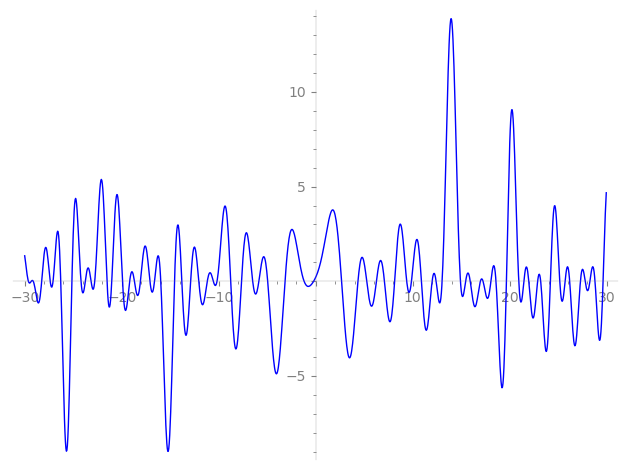| L(s) = 1 | + (−0.680 − 0.680i)2-s + (−2.44 − 1.01i)3-s − 1.07i·4-s + (0.976 + 2.35i)6-s + (−1.18 − 2.85i)7-s + (−2.09 + 2.09i)8-s + (2.84 + 2.84i)9-s + (−2.34 − 5.66i)11-s + (−1.08 + 2.62i)12-s − 1.16·13-s + (−1.14 + 2.75i)14-s + 0.703·16-s + (3.92 − 1.25i)17-s − 3.86i·18-s + (−3.83 + 3.83i)19-s + ⋯ |
| L(s) = 1 | + (−0.481 − 0.481i)2-s + (−1.41 − 0.585i)3-s − 0.536i·4-s + (0.398 + 0.962i)6-s + (−0.447 − 1.08i)7-s + (−0.739 + 0.739i)8-s + (0.946 + 0.946i)9-s + (−0.707 − 1.70i)11-s + (−0.313 + 0.757i)12-s − 0.321·13-s + (−0.304 + 0.735i)14-s + 0.175·16-s + (0.952 − 0.305i)17-s − 0.911i·18-s + (−0.880 + 0.880i)19-s + ⋯ |
\[\begin{aligned}\Lambda(s)=\mathstrut & 425 ^{s/2} \, \Gamma_{\C}(s) \, L(s)\cr =\mathstrut & (-0.0642 - 0.997i)\, \overline{\Lambda}(2-s) \end{aligned}\]
\[\begin{aligned}\Lambda(s)=\mathstrut & 425 ^{s/2} \, \Gamma_{\C}(s+1/2) \, L(s)\cr =\mathstrut & (-0.0642 - 0.997i)\, \overline{\Lambda}(1-s) \end{aligned}\]
Particular Values
| \(L(1)\) |
\(\approx\) |
\(0.147122 + 0.156896i\) |
| \(L(\frac12)\) |
\(\approx\) |
\(0.147122 + 0.156896i\) |
| \(L(\frac{3}{2})\) |
|
not available |
| \(L(1)\) |
|
not available |
\(L(s) = \displaystyle \prod_{p} F_p(p^{-s})^{-1} \)
| $p$ | $F_p(T)$ |
|---|
| bad | 5 | \( 1 \) |
| 17 | \( 1 + (-3.92 + 1.25i)T \) |
| good | 2 | \( 1 + (0.680 + 0.680i)T + 2iT^{2} \) |
| 3 | \( 1 + (2.44 + 1.01i)T + (2.12 + 2.12i)T^{2} \) |
| 7 | \( 1 + (1.18 + 2.85i)T + (-4.94 + 4.94i)T^{2} \) |
| 11 | \( 1 + (2.34 + 5.66i)T + (-7.77 + 7.77i)T^{2} \) |
| 13 | \( 1 + 1.16T + 13T^{2} \) |
| 19 | \( 1 + (3.83 - 3.83i)T - 19iT^{2} \) |
| 23 | \( 1 + (-2.88 + 1.19i)T + (16.2 - 16.2i)T^{2} \) |
| 29 | \( 1 + (-4.61 - 1.91i)T + (20.5 + 20.5i)T^{2} \) |
| 31 | \( 1 + (1.42 - 3.44i)T + (-21.9 - 21.9i)T^{2} \) |
| 37 | \( 1 + (-0.366 - 0.151i)T + (26.1 + 26.1i)T^{2} \) |
| 41 | \( 1 + (-1.57 + 0.651i)T + (28.9 - 28.9i)T^{2} \) |
| 43 | \( 1 + (0.0189 - 0.0189i)T - 43iT^{2} \) |
| 47 | \( 1 + 5.43T + 47T^{2} \) |
| 53 | \( 1 + (0.244 + 0.244i)T + 53iT^{2} \) |
| 59 | \( 1 + (2.87 + 2.87i)T + 59iT^{2} \) |
| 61 | \( 1 + (11.4 - 4.76i)T + (43.1 - 43.1i)T^{2} \) |
| 67 | \( 1 - 5.62iT - 67T^{2} \) |
| 71 | \( 1 + (-4.12 + 9.95i)T + (-50.2 - 50.2i)T^{2} \) |
| 73 | \( 1 + (-0.633 + 1.52i)T + (-51.6 - 51.6i)T^{2} \) |
| 79 | \( 1 + (2.01 + 4.87i)T + (-55.8 + 55.8i)T^{2} \) |
| 83 | \( 1 + (8.78 + 8.78i)T + 83iT^{2} \) |
| 89 | \( 1 + 3.22iT - 89T^{2} \) |
| 97 | \( 1 + (-4.94 + 11.9i)T + (-68.5 - 68.5i)T^{2} \) |
| show more | |
| show less | |
\(L(s) = \displaystyle\prod_p \ \prod_{j=1}^{2} (1 - \alpha_{j,p}\, p^{-s})^{-1}\)
Imaginary part of the first few zeros on the critical line
−10.55465777102475885250652205177, −10.17492632503960415117171321929, −8.764315342360293389088041365642, −7.65095437862172739647605733157, −6.49809200447005500504936393279, −5.86114036687418125923689874209, −4.95184098809944109413718045442, −3.16590983395583757878339734615, −1.19773990485450099828181312382, −0.21552704125838563884136930257,
2.66563620111819903492926860126, 4.35463659746212890430258218923, 5.25812830796020759421894833362, 6.25760067549741563842207896831, 7.08320788681242119434728439165, 8.131968240596411246776415427447, 9.379242837756175321149014134582, 9.868815866751631410444064673821, 10.89221774772859140569886168778, 11.99939877892759147752339758852

